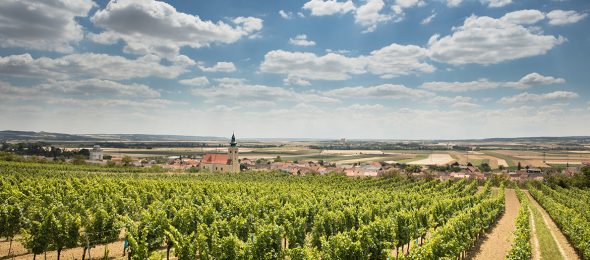Late Bud Break, Early Harvest, Delightful Finish.
In Austria’s Weinviertel, the 2018 vintage was characterized by a late bud break, rapid shoot growth, and extremely early flowering at the end of May, then high summer heat and an extraordinarily early harvest.
In 2018 budding started very late around the end of April, followed by an unusually warm period for the spring season. The growth of shoots caught up very quickly, and the result was one of the earliest flowering periods anyone has experienced in this winemaking region: In the eastern Weinviertel, where the Pannonian warmth influences the local climate most intensely, the first caps fell away by mid-May. In general, flowering was completed by the beginning of June. Weather conditions at that time were excellent – good news for the winemakers, as this period is decisive for the fruit setting on the vine. A small hailstorm near the city of Poysdorf shortly after flowering didn’t cause too much damage, as vines hit at an early enough stage are able to replace their broken shoots.
As in all of Austria, last summer in the Weinviertel was extremely hot with a series of heat waves (more than 30° C for more than five days) including tropical nights with temperatures above 20° C. Veraison started in early July, while in normal years it takes places a month later. The grapes ripened incredibly quickly, and the harvest started very early on the 20th of August.
Due to the high temperatures during the day, several winemakers decided to start harvesting at sunrise in order to benefit from the cooler conditions at this time. After rainfall of about 100 mm at the beginning of September, warm conditions continued until the 20th of September, when a fundamental change in the weather occurred with massive rainfall, cooler temperatures and a pronounced difference between day and night temperatures. The harvest had to be interrupted. In 2018, the Weinviertel had 100 mm less precipitation overall compared to its annual average 450 mm of rain.
The timing of the rainfall in 2018 was a positive factor, as it quite often occured when it was urgently needed. From the southwestern part of the Weinviertel to the community of Röschitz on the western side close to Manhartsberg, several thunderstorms over the summer months supplied the necessary moisture. Around the village of Ziersdorf, three smaller rain events provided 20 liters (twice) and 50 liters, enough water to guarantee good vine development. The large regional differences across very short distances, such as in the Pulkautal close to Retz, were very unusual: One village had rain in small quantities but exactly when it was needed, whereas the neighbouring village just a few kilometers away experienced the opposite and remained dry. On the other hand, massive downpours around Poysdorf caused problems as the heated soil couldn’t absorb the huge amount of water coming down in a very short time. Foliage and cover crop management were very important for the quality of the 2018 vintage wines, and a sensitive strategy for handling the canopy was necessary to find the appropriate balance between fruit and foliage development.
All‘s well that ends well
The total amount of 87,8 million litres wine produced corresponds to the higher annual average for the Weinviertel. At the end of the day, winemakers in all parts of this large winemaking region were quite satisfied with the quality of the grapes they harvested. For wines with a pronounced fruit-dominated character such as Weinviertel DAC, an early harvest before the 20th of September was the best choice. For late-ripening varieties such as Rieslings from the granite soils of the western Weinviertel or Veltliner in the “Reserve“ category, winemakers had to patiently wait for dry conditions in early October in order for the wines produced to shine with their structure and typicity. Grüner Veltliner, especially from older vines, coped much better with the dry conditions than its need for a good nutrient supply would have indicated. The late-maturing Riesling from the western Weinviertel has been described as particularly harmonious. In all parts of this winemaking region, the balance of the respective varieties has been particularly emphasised. The 2018 vintage here is in the end quite satisfactory.
Photo credits: (reprint free of charge for editorial use) © Regional Wine Committee Weinviertel/Anna Stöcher

